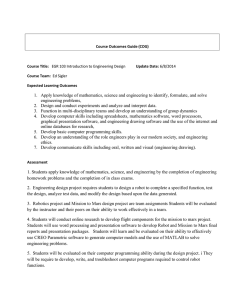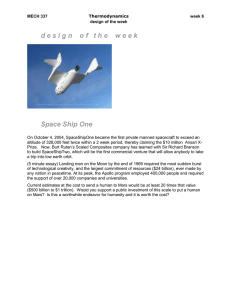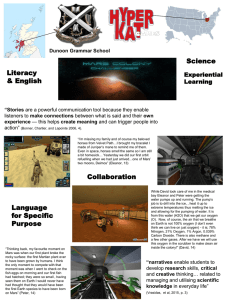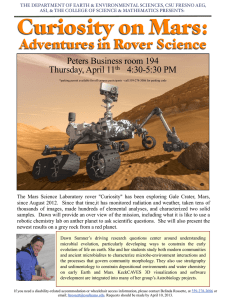1. Apply knowledge of mathematics, science and engineering to
advertisement
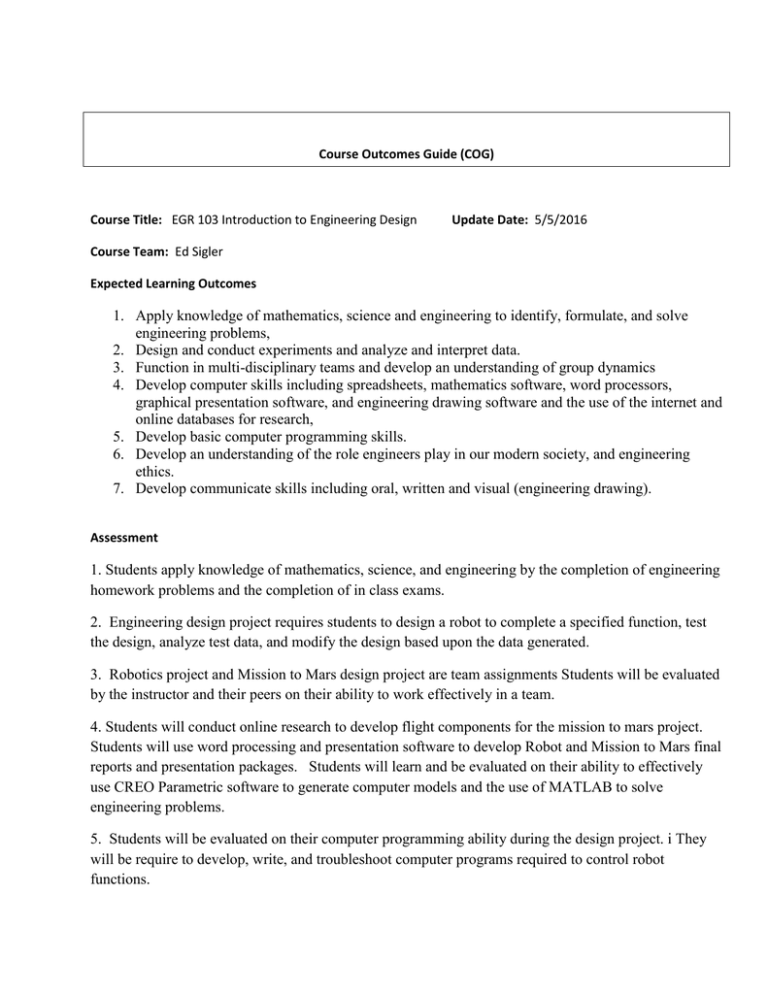
Course Outcomes Guide (COG) Course Title: EGR 103 Introduction to Engineering Design Update Date: 5/5/2016 Course Team: Ed Sigler Expected Learning Outcomes 1. Apply knowledge of mathematics, science and engineering to identify, formulate, and solve engineering problems, 2. Design and conduct experiments and analyze and interpret data. 3. Function in multi-disciplinary teams and develop an understanding of group dynamics 4. Develop computer skills including spreadsheets, mathematics software, word processors, graphical presentation software, and engineering drawing software and the use of the internet and online databases for research, 5. Develop basic computer programming skills. 6. Develop an understanding of the role engineers play in our modern society, and engineering ethics. 7. Develop communicate skills including oral, written and visual (engineering drawing). Assessment 1. Students apply knowledge of mathematics, science, and engineering by the completion of engineering homework problems and the completion of in class exams. 2. Engineering design project requires students to design a robot to complete a specified function, test the design, analyze test data, and modify the design based upon the data generated. 3. Robotics project and Mission to Mars design project are team assignments Students will be evaluated by the instructor and their peers on their ability to work effectively in a team. 4. Students will conduct online research to develop flight components for the mission to mars project. Students will use word processing and presentation software to develop Robot and Mission to Mars final reports and presentation packages. Students will learn and be evaluated on their ability to effectively use CREO Parametric software to generate computer models and the use of MATLAB to solve engineering problems. 5. Students will be evaluated on their computer programming ability during the design project. i They will be require to develop, write, and troubleshoot computer programs required to control robot functions. 6. Students are evaluated on their understanding of the role of engineers in society and engineering ethics by the writing of short research papers on the topics. 7. Students interact within the Robot and Mission to Mars design project teams where they communicate within their teams. Students prepare a written report detailing development, design and results for both projects. Further, each member of the Mission to Mars teams is required to prepare and present to the class. Validation Exams for each section will contain the same questions. Exams will be analyzed to see if students, on average, demonstrate common area of weaknesses. Projects are assessed against the consistent criteria for each section and semester. Results Data from Fall 2012, Fall 2013, Spring 2014, Fall 2014 Spring 2015 has been analyzed. below. See Table Major findings: 1. Through 2013, students were required to develop a research paper individually and present to the class. The general feedback from the students indicated general disinterested in the assignment. As a major goal of the course is to allow students to develop skills necessary for group/team assignments, the individual research paper was modified to a group activity that reinforces the 6 steps of the design process. The Mission to Mars project was in Fall 2014 instituted and requires the students to work as a team, follow the design process and develop group participation skills. The majority of students have provided very positive feedback on the project. 2. A large majority of students have not had basic computer programming in high school. Math workspace software requires significant time and continued re-enforcement through inclusion within other activities. 3. Basic trigonometry and vector mathematics is an issue for some students. 4. The alternating lab/lecture schedule works well unless there are significant schedule disruptions. Spring 2015 had numerous snow delays which caused the early morning class to be cancelled. This caused some schedule compression and schedule rework. This contributed to student poor scores. In general, students seemed to be very dis-engaged for the duration of this course. Follow-up 1. For Finding 1 -- The individual research assignment was changed in SP 14 to a group research and design project -- Mission to Mars where multi-member teams (3-4) students are assigned a component of an envisioned Mission to Mars spacecraft where the students must perform research, collaborate internal to the team and also external with other teams, generate a detailed report and present the findings to the class. The reception to this project was much improved over the individual assignment. 2. For Finding 2 -- MATLAB will become a focus for re-enforcement within EGR 103 and other engineering courses. 3. A trig and vector review will be incorporated into the initial course lectures for review of concepts to assist students as these concepts are fundamental to the solution of many engineering problems. 4. Revisit course lecture schedule to develop flexibility. Also, work with Division chair to establish MATLAB course required for engineering students outside of EGR 103 – this will allow concentration on engineering fundamentals and engineering drawing packages. Course: EGR 103 # Active students %W *# walk-away Fs No final exam/grade = F % Success (A,B,C) Common Comprehensive Final Exam Score Average Mean course grade Item Analysis Weakest Content Areas SLOA Data Faculty Team: E. Sigler FA 2012 SP 2013 FA 2013 SP 2014 FA 2014 SP 2015 FA 2015 SP 2016 33 ? 32 13 23 12 24 14 15% ? 10% 0% 5% 25% 0% 7% 4 ? 2 0 6 2 1 3 78.6 ? 90 100** 75%** 87.5% 78.6% 73.3 N=24 ? 74.7 N= 72.2 N= 13 77.08 N=16 49.9 N=9 75.0% N=22 69.0% N=11 2.43 ? 2.83 3.00 2.18 2.0*** 2.58 2.36 ? Problem Solving (Electrical Circuits) Problem Solving (Statics) Problem Solving (Conceptual with unit conversions) Problem Solving (Conceptual, Statics, Mech of Materials) Problem Solving (Statics) Problem Solving (Electrical Circuits; Unit Conversions) Problem Solving (Electrical Circuits) FA 2017 SP 2017 *% Walk-away Fs = Did not take the final exam and received a grade of F. ** - 1 student changed to AU prior to end of class. *** - Students missed 3 class periods due to snow days. However, material was covered in class with examples and discussions.
